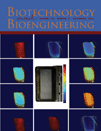Microfluidic Bubbler Facilitates Near Complete Mass Transfer for Sustainable Multiphase and Microbial Processing
Abstract
A microfluidic device (channels <70 μm) was utilized to create micro-scale bubbles to significantly increase mass transfer efficiency at low flow rates. The convergence of one gas and two liquid channels at a Y-junction generates bubbles via cyclic changes in pressure. At low flow rates, the bubbles had an average diameter of 110 μm, corresponding to a volumetric mass transfer KLa of 1.43 h−1. Values of KLa normalized per flow rate showed that the microbubbler had a 100-fold increased transfer efficiency compared to four other commonly used bubblers. The calculated percentage of oxygen transferred was approximately 90%, which was consistent with a separate off-gas analysis. The improved mass transfer was also tested in an algae bioreactor in which the microbubbler absorbed approximately 90% of the CO2 feed compared to 2% in the culture with an alternative needle bubbling method. The microbubbler yielded a cell density 82% of the cell density for the alternative needle tip with an 800-fold lower flow rate (0.5 mL/min versus 400 mL/min) and a 700-fold higher ratio of biomass to fed carbon dioxide. The application of microfluidics may transform interfacial processing in order to increase mass transfer efficiencies, minimize gas feeding, and provide for more sustainable multiphase processes.

